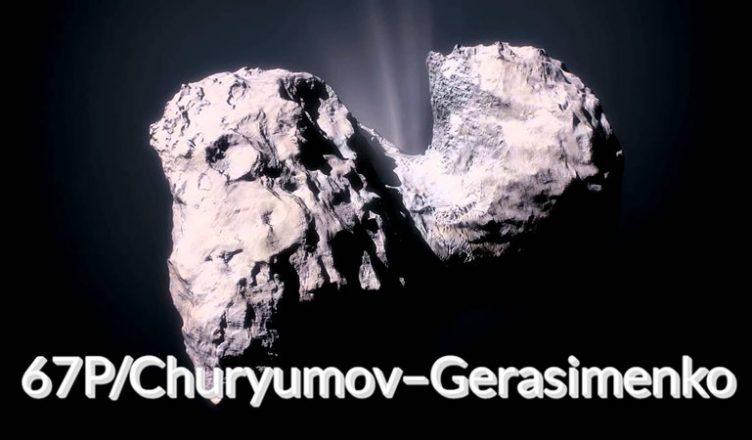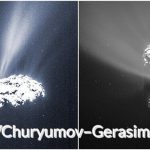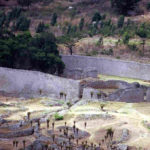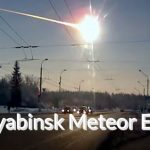The evolution of the universe often baffles us, and with every new discovery, humans are left in awe of the cosmic creator’s wonders, such as the union of two distant objects! The Rosetta spacecraft from the European Space Agency captured this photograph as a comet approached. This comet is known as 67P/Churyumov–Gerasimenko, and it was the subject of a two-year investigation by the Rosetta spacecraft.
The Rosetta spacecraft, a part of the European Space Agency’s unmanned space mission, was launched on March 2, 2004, with its primary mission being to explore the mysteries of the solar system’s origins 4.6 billion years ago and to determine whether comets provided the necessary water and organic compounds for life’s emergence on Earth. On September 30, 2016, the Rosetta spacecraft collided with the 67P/Churyumov–Gerasimenko comet, losing contact with Earth and officially ending its 12-year journey of “chasing stars.” Throughout its descent, the diligent little spacecraft remained in full scientific operation. It continuously transmitted a wealth of high-resolution images and other data back to Earth, leaving us with important clues to unlock the mysteries of this comet, even up until its final moments.
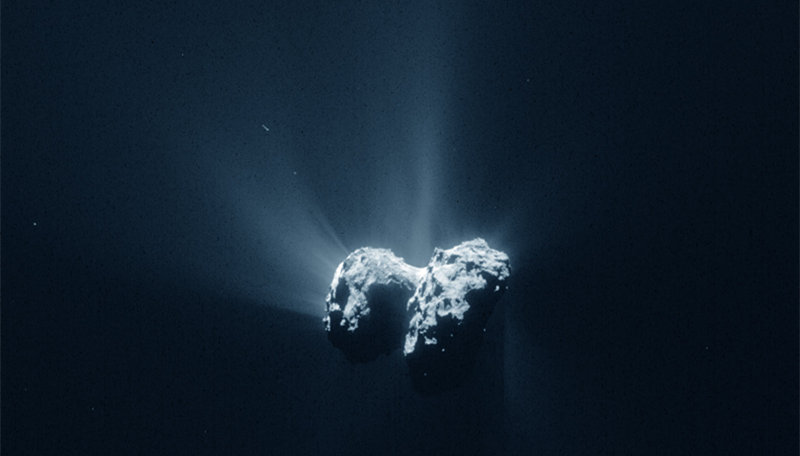
The Comet 67P/Churyumov–Gerasimenko: Past and Present
67P/Churyumov–Gerasimenko was first discovered by Soviet astronomers Churyumov and Gerasimenko in 1969, who subsequently named it after themselves. This comet has a perihelion (closest approach to the Sun) distance of 5.68 astronomical units (AU), an orbital period of 6.45 years, an orbital inclination of 7.04 degrees, a rotation period of 12.4 hours, a mass of approximately 10^13 kilograms, and an average density of 0.4 grams per cubic centimeter. It is considered a typical Jupiter-family comet.
Jupiter-family comets are characterized by orbital periods of fewer than 20 years, perihelion distances near Jupiter’s orbit, and orbital inclinations of less than 30 degrees. They are believed to originate from the Kuiper Belt, beyond the orbit of Neptune, with occasional perturbations causing them to be ejected into the inner solar system. Under the gravitational influences of the Sun and Jupiter, 67P’s perihelion distance has been continuously changing. Prior to 1840, it was at 4 AU; it decreased to 3 AU by 1840. In February 1959, a close encounter with Jupiter shifted its perihelion to 1.29 AU. The most recent perihelion passage occurred on November 3, 2021, with a perihelion distance of 1.21 AU. The next significant change in perihelion distance will take place in November 2220 when 67P will make a close flyby at just 0.12 AU from Jupiter, subsequently reducing its perihelion distance to 0.8 AU.
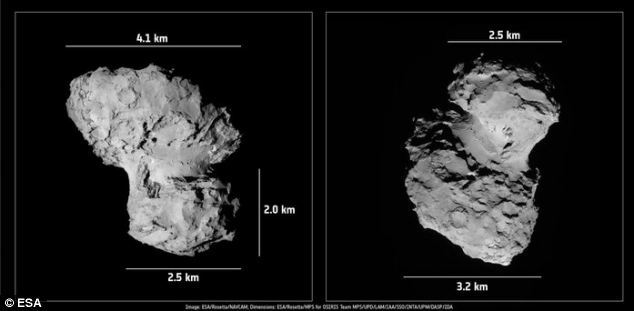
Reasons for the Formation of a Bilobed Shape:
The bilobed shape of 67P/Churyumov-Gerasimenko is the result of the combined action of rotational forces and internal geological stress during its shape evolution. Here are the key factors explaining why it is a bilobed comet formed by rotational forces:
- Rotational Forces: The comet continually rotates around its orbit. This rotation results in two effects: firstly, it generates an outward centrifugal force, causing the two parts of the comet to expand outward. This can be visualized as similar to a rapidly spinning ellipsoid that becomes flattened due to the centrifugal force, with both lobes extending outward.
- Shear Stress: The asymmetry of the comet and the action of centrifugal forces create shear stress within the comet’s interior. Shear stress is a mechanical force typically occurring in the geology and glaciers of Earth and other planets. Shear stress arises when two objects or masses move relative to each other and create displacement forces. On the comet, this shear stress leads to the formation of internal faults and fractures.
- “Neck” Region: The middle part of the comet, which connects the two lobes, is typically the thinnest. This is because shear stress is concentrated here, resulting in mechanical erosion of this area and making it thinner.
- Torque Effect: The comet’s rotation and its initial asymmetrical shape lead to the formation of torque, or moments of force, in the “neck” and “head” regions. These torque effects guide the comet’s shape evolution, including thinning of the “neck.”
As a result, the bilobed shape of 67P/Churyumov–Gerasimenko is the outcome of the interaction between centrifugal forces induced by rotation and shear stress, causing the two lobes to extend outward while thinning the “neck.” These interactions produce the unique bilobed shape.
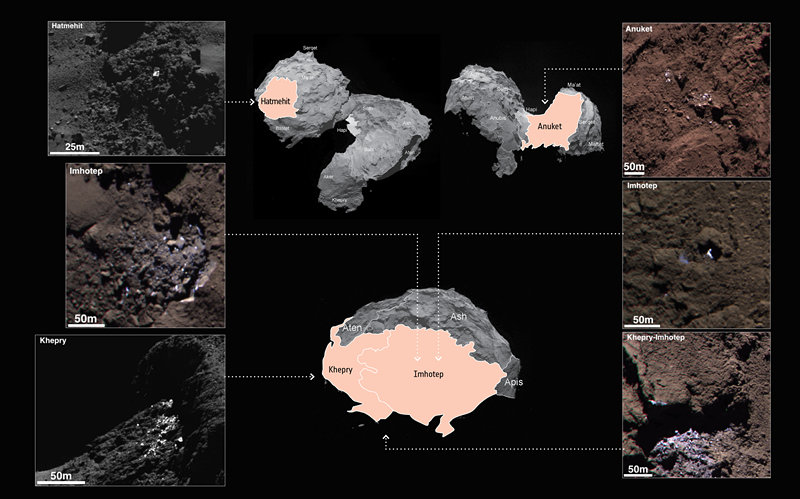
The European Space Agency’s Rosetta Mission and Observations of Comet 67P/Churyumov–Gerasimenko:
- Rosetta Mission: The European Space Agency’s (ESA) Rosetta mission spanned two years and involved an in-depth exploration of Comet 67P/Churyumov–Gerasimenko. The mission concluded at the end of September 2016.
- Image Capture: During the Rosetta mission, a significant number of images were captured, and these images are now available for free on ESA’s Rosetta website.
- Discovery of Debris: Spanish amateur astronomer Jacinto Roger discovered a chunk of ice moving around the comet 67P while processing these images. He created an animation that focused on this chunk of ice.
- “Churymoon”: This piece of ice was named “Churymoon,” and its diameter is estimated to be less than 4 meters (13 feet) based on the analysis of images captured by the Rosetta spacecraft.
- Scientific Research: Scientists from the Rosetta mission and the OSIRIS team are closely studying this piece of debris to understand its trajectory and properties. Analysis suggests that this object was ejected from the comet, and it has been observed moving around the comet.
- Significance of the Rosetta Mission: The mission revealed the geological complexity of comets, challenging the conventional view that comets are merely dirty ice chunks. The mission also raised the possibility that Comet 67P might be the result of a collision between two comets, enhancing our understanding of comets. The internal structure and activities of the comet have piqued the interest of scientists.
These detailed key points summarize the essential aspects of the Rosetta spacecraft mission and the new discoveries about Comet 67P, including specific data and research findings.
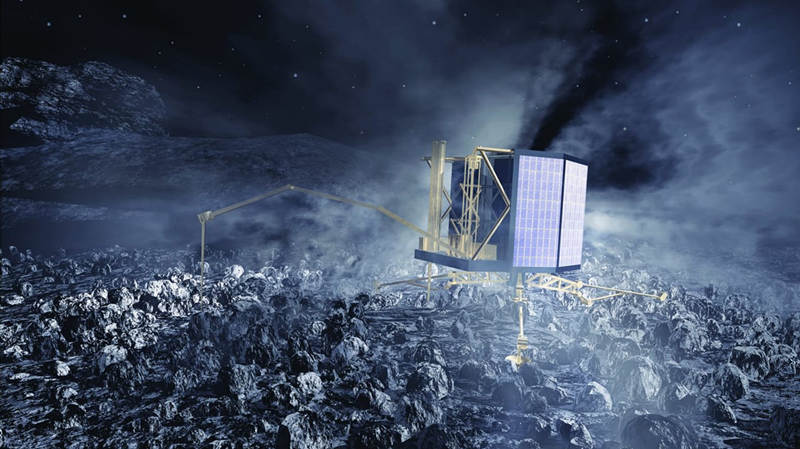
“Rosetta” Mission’s Key Scientific Discoveries:
1. Surface Features: Images captured by the “Rosetta” spacecraft revealed that the nucleus of Comet 67P has two distinct lobes with an average diameter of 4.2 kilometers, measuring approximately 4.3 kilometers × 4.1 kilometers at its longest and widest points. The surface of Comet 67P is rough and features cliffs, boulders, crevices, pits, dunes, and ridges. Images taken during the descent before the landing of Philae suggest that the comet’s surface is covered with millimeters to meters of dust and pebbles, with an initial estimate of 10-20 centimeters of surface regolith.
2. Chemical Composition: Scientific investigations by “Rosetta” indicate that Comet 67P is a conglomerate of very loose water ice, dust, and rocks. The main components of the released gases include ammonia, methane, hydrogen sulfide, hydrogen cyanide, and formaldehyde, resulting in a mixed odor resembling rotten eggs, horse urine, alcohol, and bitter almonds. The deuterium content serves as an important probe for the formation and early evolution of the solar system. The composition of water vapor from 67P differs significantly from that on Earth, with a deuterium-to-hydrogen ratio three times higher than in Earth’s oceans. This suggests that water on Earth likely did not originate from comets like 67P. Significantly, free molecular oxygen (O₂) was detected in the gases around 67P, marking the first time O₂ has been observed in a comet’s coma. There are two competing theories about its origin: one suggests it was present since the comet’s formation, and the other proposes it was produced on the comet’s surface by collisions of water molecules with silicates and other oxygen-containing substances. “Philae” also detected 16 organic compounds on 67P, including four that were discovered for the first time on a comet, such as acetamide, acetone, methyl isocyanate, and propionaldehyde.
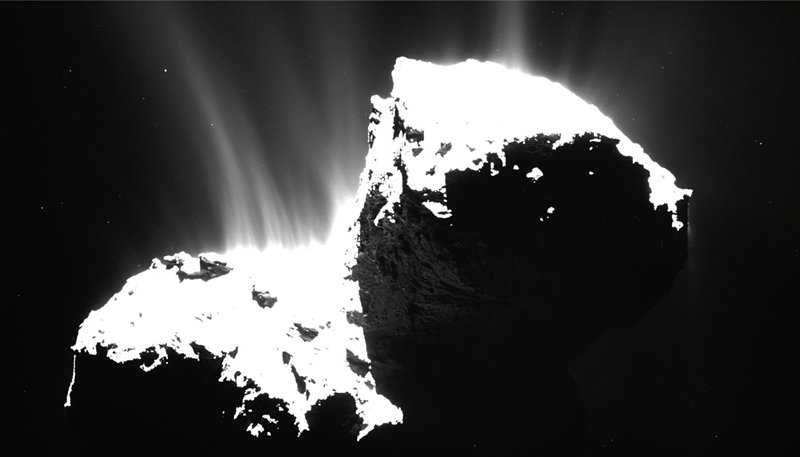
3. Activity: As a Jupiter-family comet, 67P’s activity is primarily driven by the sublimation of water ice. Theoretically, for a comet with uniform activity distribution, the production rate of water ice gradually increases as it approaches perihelion. However, “Rosetta” discovered that the activity region on the surface of the 67P nucleus is not uniform, and water production increased sharply in the months leading up to perihelion. The main reason is believed to be the summer season in the southern hemisphere of the comet’s nucleus, which allowed heat to penetrate deeper into the nucleus, expanding the activity region. “Rosetta” also found that there are jets and other near-nucleus structures within the comet’s coma. These jets are associated with specific regions on the nucleus’s surface, and they occur not only on the sunlit side but also on the dark side. However, due to the extremely irregular shape of the 67P nucleus, the sources of these jets remain unclear.
END:
As we delve deeper into our research, the future prospects of 67P/Churyumov-Gerasimenko become increasingly captivating:
- Continued Research:Thanks to the Rosetta mission and ongoing scientific investigations, our understanding of 67P is becoming increasingly detailed and complex. Future research will further explore the geological complexities and activities of this comet.
- Unlocking the Comet‘s Origins:The unusual shape and structure of 67P have long puzzled scientists, but recent studies suggest it might be the result of a collision between two comets. Future research will delve deeper into understanding the comet‘s origins and formation processes.
- Study of Fragments:The discovery of fragments expelled from the comet during its close approach to the Sun has provided valuable insights into the comet‘s internal and surface structure. Future research will continue to study these fragments to gain a better understanding of the comet’s evolutionary history.
- Exploration of Complexity:67P/Churyumov–Gerasimenko has been shown to be a geologically complex world with countless processes at play, creating its incredible surface structure and activities. Future research will further explore the internal structure and activities of the comet, shedding light on the formation and evolution of the solar system.
- Scientific Interest:The complexity and uniqueness of this comet have sparked intense interest among scientists. Future research will delve deeper into uncovering more secrets about the formation and evolution of the solar system.
In summary, future research will continue to deepen our understanding of 67P/Churyumov–Gerasimenko, unravel more mysteries about comet formation and evolution, and provide further insights into the origins and evolution of the solar system. This comet will remain a focal point of scientific interest and play a crucial role in advancing our knowledge of the cosmos.
More UFOs and mysterious files, please check out our YouTube channel: MysFiles
Mysterious Stone Spheres around the world – Costa Rica, European forest, Russia, Kazakhstan
